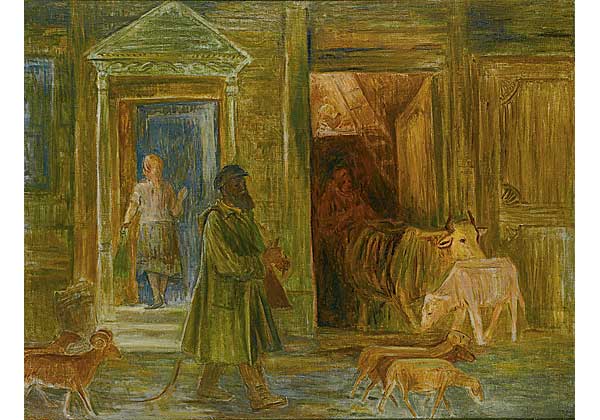
artist:
Shchipitsyn, Alexander Vasilievich
Shchipitsyn, Alexander Vasilievich
technique:
Oil on canvas
Oil on canvas
size
64 х 85
year
1935
Shchipitsyn, Alexander Vasilievich
(b. 1897 Nizhny Novgorod – d. 1943 Moscow)
Painter
1921–1925 – Studied at Nizhny Novgorod State Art School under A. Kuprin.
1925–1930 – Studied at Vkhutemas-Vkhutein [Higher Art and Technical Studios and Institute] under A. Drevin, R. Falk, and D. Shterenberg.
1929–1932 – Participated in V. Tatlin’s work constructing the famous Letatlin human-powered flight machine in Tatlin’s studio in the tower of Novodevichy Convent.
Took part in exhibitions beginning in 1929. Member of the Growth group, OST [The Society of Easel Painting] and RAPKh [The Russian Association of Proletarian Artists].
“I never personally witnessed Shchipitsyn in the process of painting, but my father, who considered him to be a master painter, used to recount how Shchipitsyn worked. He did not paint from life, so he did not turn to the brush every day, but would take time to think things through. Whenever he came to a decision about how he wanted to paint something, he would put a stool and an easel with a clean canvas in the middle of the room. On the stool he would place a palette and a box of paints. This way, he would have to encounter the stool and step over it each time he walked from the door to the table or vice versa. Thus, the paints and canvas forced him to start working because they interfered with his movement around the room. From that moment on, he would disappear for a week or maybe ten days. Our family knew that he was engaged in his work. He would complete his painting in that time frame and almost never return to it again.Shchipitsyn’s palette was small, polished and clean. He loved to paint using round sable-hair brushes. He would first paint with thick paints, rubbing them into the primed canvas, and then would glaze them over. He was very careful with his paints, as were the master painters of old. He never squeezed all of the colours out onto the palette together in advance, but only as he had need of each one. He couldn’t stand it when the paints were mixed together indiscriminately. Shchipitsyn had studied under Vladimir Yevgrafovich Tatlin and shared Tatlin’s understanding of materials. He usually primed his canvases himself, although some of his works are painted on French pre-primed canvases. Sometimes he would add wax to his paints.”
Sofia Zelenskaya
“Alexander Vasilievich Shchipitsyn. 1896—1943.” Katalog [calaloguel. M.: Sovetsky Khudozhnik, 1982. Pp. 8, 10.


